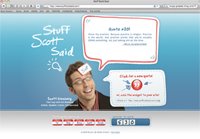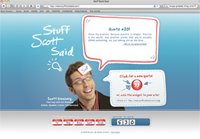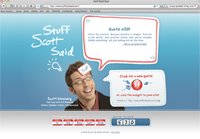 Stick-to-itiveness can be learned.
Stick-to-itiveness can be learned.
Aka, “Stick to it.”
Aka, “Stick with it.”
Aka, “Stick in there.”
All you have to do is shift your attitude completely – work hard, smart and long while nobody notices – and design a daily practice of self-determination and commitment.
Hey. I said it could be learned – not that it would be easy.
Up to the challenge?
Cool. Fortunately, I’ve already published part one, part two and part three in this series.
Today we’re going to explore part three with additional strategies for sticking with it – whatever “it” is:1. Shut yourself up. In 1933, newspapers around the world announced the death of a Chinese man named Li Chung Yun. Now, the rumor was that he lived to be over two hundred years old. Whether or not that’s true, nobody knows.
But Yun did deliver a series of twenty-eight three-hour lectures at a Chinese university. The topic: Longevity. And when asked for advice on lengthening one’s life, his greatest counsel for stick-to-itiveness was always two words: Inner quiet.
When was the last time those two words described your mindspace? For most people, that’s a tough question. For some people, that’s an impossible question. But that’s why Yun’s philosophy of inner quiet is more relevant than ever before.
The reality is: Our society doesn’t reward idleness. Money likes speed, not stillness. And when you factor in the information overload, the acceleration of technology and the (almost) non-existent attention span – it’s no wonder people can’t shut themselves up.
Have you ever actually tried just doing nothing? It’s like a workout. Apparently non-action is the hardest action of all. But in my experience, practicing regular intervals of inner quiet – every day – is the backbone of stick-to-itiveness. Tomorrow’s strength comes from yesterday’s stillness. At what point did you shut your brain down yesterday?
2. Find a place to put the fear. Are you scared? Perrrrrfect. Fear is a great compass for finding what matters. You just have to be bold enough to put your arm around fear’s shoulder and listen to what it’s trying to tell you. The world isn’t trying to knock you down – it’s trying to educate you.
The question is: Are you willing take notes? That’s when stick-to-itiveness develops. When you’re willing to view your shitstorm as a tempering experience. And when you’re faithful that there are many answers waiting for you to find them.
Here’s one of the mantras that keeps me going: “I look forward to looking back on this.” With that attitude, you approach your fear – which, by the way is completely human and natural and expected – as a teaching mechanism. You stop trying to change what you are only able to understand. What scared you this week?
3. Unholster the humor. In the documentary Why We Laugh, author, comedian and activist Cornell West explained:
“Humor is a diversion from despair. We laugh to keep from crying. And comedy is the tool of the spirit to pass through the wilderness of misery.”
It’s easy to get over things once you figure out what’s funny about them. And if you think you’re not funny, look again. If you’re a human, you’re funny. The challenge is excavating the constant and inherent hilariousness of your daily experiences.
Here are a few questions you might ask throughout your day: What’s funny about this? How can this mistake morph into something positive and humorous? What is the funny message the universe is trying to give me through this?
Ultimately, your answers will build a foundation of funny to help you melt on through the tough times. Humor doesn’t have to trivialize your tribulations. Every step is a spark that defies the darkness. How will you laugh your way through the struggle?
4. Develop strategies for responding to resistance. I’ve been playing guitar for almost twenty years. And I’ll never forget what my teacher taught me on our very first lesson: “If you break a string, don’t freak out. Everybody does it. What matters is how quickly you return to the music.”
That same principle of stick-to-itiveness applies to the song of life. My suggestion is to practice noticing things before letting them nag you. Don’t allow the world to choose for you. The most expedient way to overcome opposition is to respond, not react. The difference is that reacting is a reflex – responding is a choice.
In Grounded Optimism, my friend Kristi Govertson summarized this idea beautifully, “Sticks and stone will break my bones but the words I tell myself and choose to agree with either hinder or hurt me.”
The point is: You always have a choice. Always. Strength comes from facing storms. But not from inside your cozy house with your nose pressed against the glass. Instead, from bolting out the door and dancing in the rain. What fuels your strength to remain steadfast in your aims?
REMEMBER: It takes guts to stick yourself out there – but it takes gusto to keep yourself out there.
LET ME ASK YA THIS…
What’s your secret for sticking with it?
LET ME SUGGEST THIS…
For the list called, “13 Ways to Out Develop Your Competitors,” send an email to me, and I’ll send you the list for free!
* * * *
Scott Ginsberg
That Guy with the Nametag
Author, Speaker, Entrepreneur, Mentor
[email protected]
 Who’s quoting YOU?
Who’s quoting YOU?
Check out Scott’s Online Quotation Database for a bite-sized education on branding success!

 Stick-to-itiveness can be learned.
Stick-to-itiveness can be learned. Who’s quoting YOU?
Who’s quoting YOU? Aka, “Stick to it”
Aka, “Stick to it” Who’s quoting YOU?
Who’s quoting YOU? Pharmaceutical companies are well known for having an abundance of three things:
Pharmaceutical companies are well known for having an abundance of three things: Who’s quoting YOU?
Who’s quoting YOU?